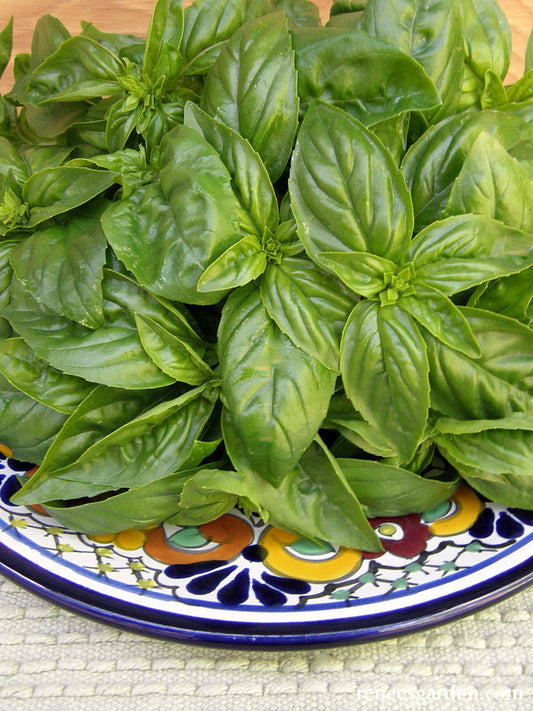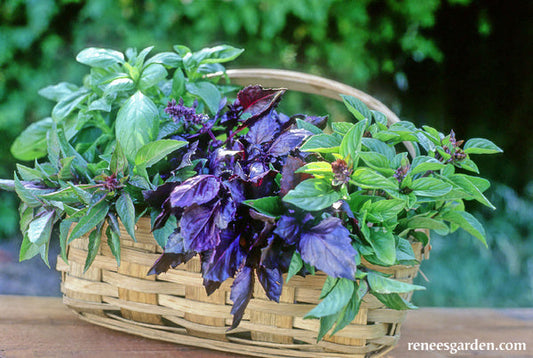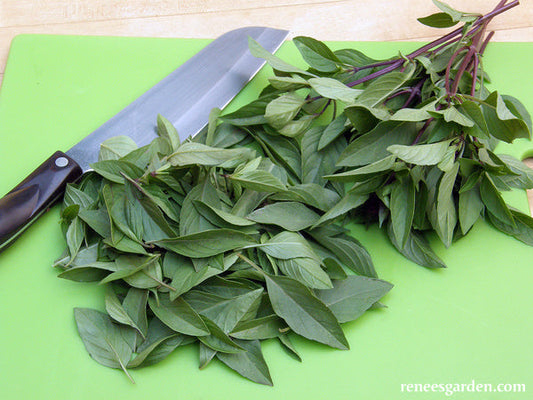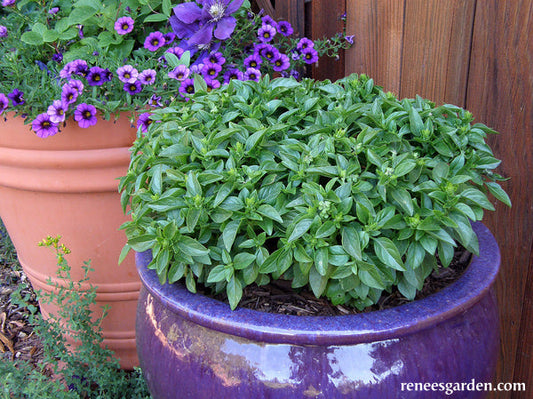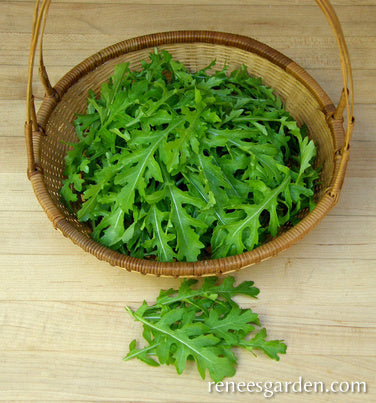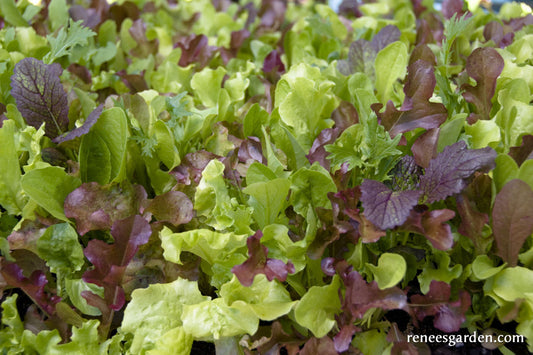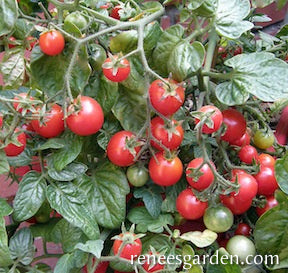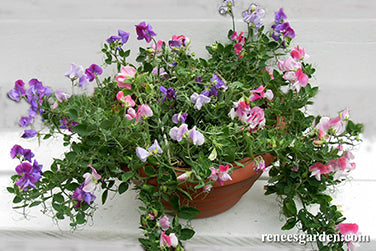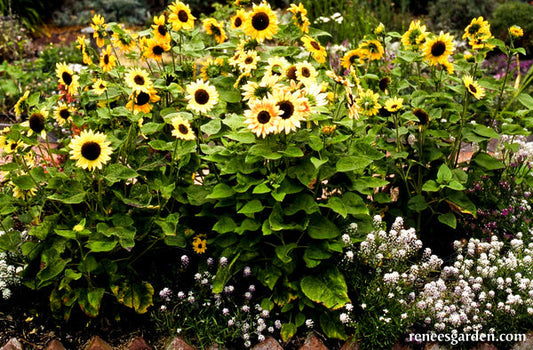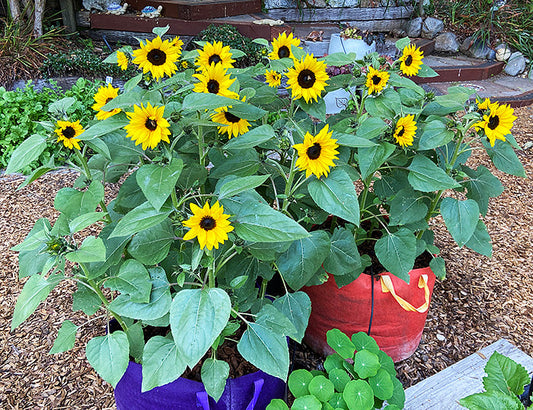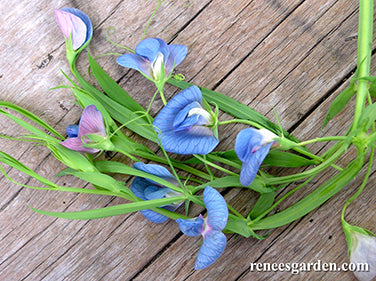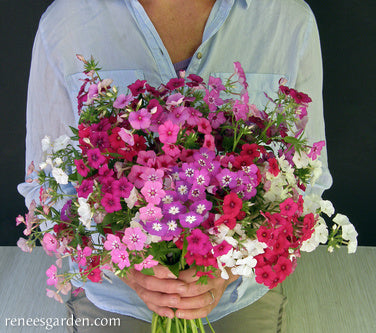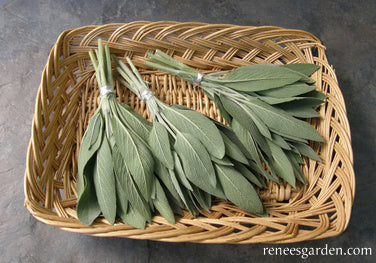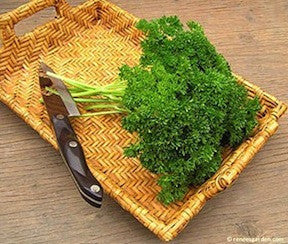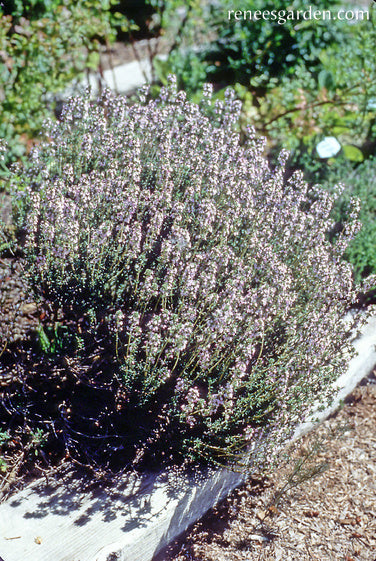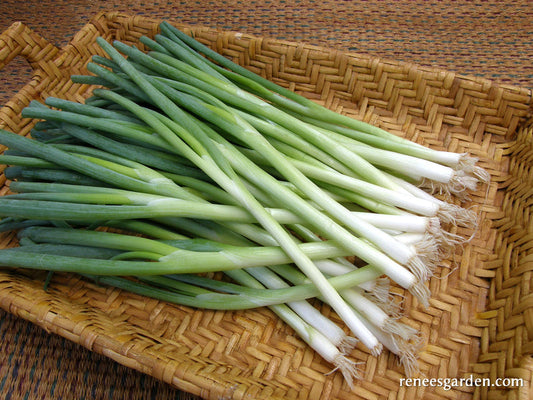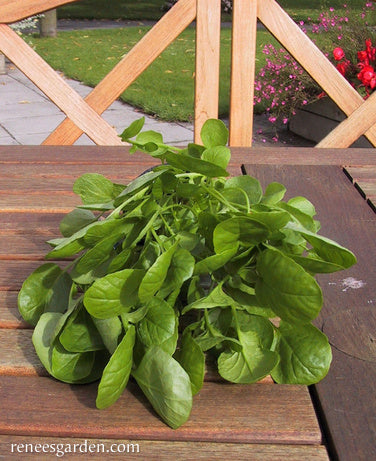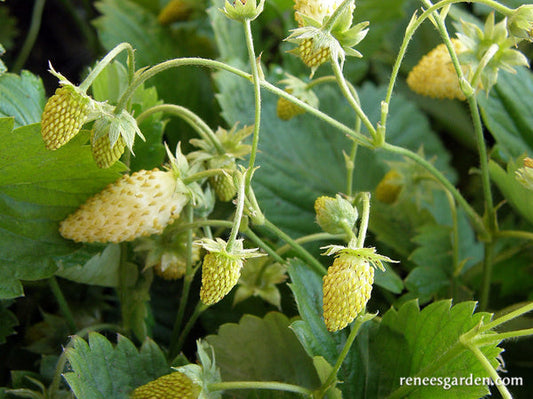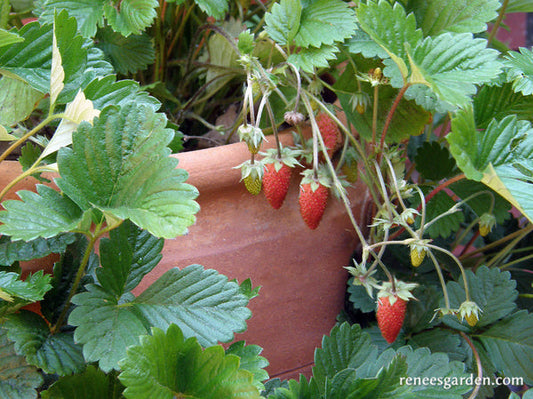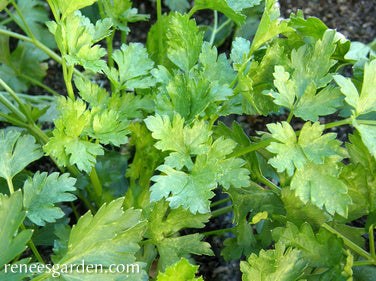Container Friendly
Space-Saving Varieties are Our Specialty
Grow a cheerful profusion of flowers and savory herbs in containers of all shapes and sizes on your patio, small deck, or rooftop.
-
Heirloom Basil Italian Genovese
ANNUAL
Summer/fall harvest
Heat-loving, frost tenderTO PLANT DIRECTLY INTO THE GARDEN
When late spring weather has thoroughly warmed up, sow seeds 1 inch apart in well worked fertile soil in full sun. Cover 1/4 inch deep, firm soil and keep seedbed moist. Germination takes 1 to 2 weeks. After seedlings are well established, thin or transplant 8 inches apart to allow plants room to mature.
TO START EARLY INDOORS
Sow seeds 1 inch apart in a container of seed starting mix, 4 to 6 weeks before last expected frost. Keep warm and evenly moist, and provide a good light source. When seedlings are large enough to handle and weather is warm, acclimate gradually to outdoor conditions before planting in the garden 8 inches apart.
GROWING NOTES
Remember — it is critical to plant basil in the garden only after late spring day and nighttime temperatures stay above 50°F (10°C). Pinch off growing tips when plants are 6 to 8 inches tall to encourage branching. Harvest sprays of leaves by cutting stems just above two new sprouting lateral branches to get lush regrowth. Keep flower buds pinched off to extend harvesting and feed regularly to promote new growth.Regular price $4.89Sale price $4.89Unit price / per -
Kitchen Herbs Scented Basil Trio
ANNUAL
Summer/fall harvest
Heat-loving, frost tenderTO PLANT DIRECTLY INTO THE GARDEN
When late spring weather has reached the 55°F (13°C), sow seeds 1 inch apart in well worked fertile soil in full sun. Cover 1/2 inch deep, firm soil and keep seed bed moist. Germination takes 1 to 2 weeks. After seedlings are well established, thin or transplant 8 inches apart to allow plants room to mature.
TO START EARLY INDOORS
Sow seeds 1 inch apart in a container of seed starting mix, 4 to 6 weeks before last expected frost. Keep warm and evenly moist, and provide a good light source. When seedlings are large enough to handle and weather is above 55°F (13°C), acclimate gradually to the outdoors, then plant in the garden or into large pots.
GROWING NOTES
Remember—for success with this easy to grow herb, it is critical to sow or transplant basil into garden beds only when late spring day and night temperatures stay above 55°F (13°C). Harvest sprays of leaves by snipping stems just above two new sprouting lateral branches to encourage lush foliage. Keep flower buds pinched off to extend harvesting and feed regularly to promote new growth.Regular price $3.69Sale price $3.69Unit price / per -
True Thai Basil Queenette
ANNUAL
Summer/fall harvest
Heat-loving, frost tenderTO PLANT DIRECTLY INTO THE GARDEN
When late spring weather has reached the 50°F (10°C) range day and night, sow seeds 1 inch apart in well worked fertile soil in full sun. Cover 1/2 inch deep, firm soil and keep seed bed moist. Germination takes 1 to 2 weeks. After seedlings are established, thin or transplant 8 inches apart so plants have room to grow.
TO START EARLY INDOORS
Sow seeds 1 inch apart in containers of seed starting mix, 4 to 6 weeks before last expected frost. Keep warm and evenly moist, and provide a good light source. When seedlings are large enough to handle and night temperatures stay above 50°F (10°C), acclimate gradually to outdoor conditions before planting in garden beds or into large pots.
GROWING NOTES
Remember, for success with this easy to grow but cold-sensitive herb, it is essential to sow and/or transplant basil only when weather is warm and nighttime temperatures stay above 50°F (10°C). Harvest sprays of leaves by snipping stems just above two new sprouting lateral branches to encourage lush foliage. Keep flower buds pinched off if you want to extend harvesting. Feed regularly to promote new growth.
Regular price $2.99Sale price $2.99Unit price / per -
Heirloom Container Basil Spicy Globe
TO PLANT DIRECTLY IN THE GARDEN
Spicy Globe seeds are coated with a natural clay material to make them easy to sow. When late spring weather has warmed up to the 50°F (10°C) range both day and night, sow seeds 1 inch apart in well worked, fertile soil or containers of fresh potting mix in full sun. Cover 1/4 inch deep, firm soil and keep the seed bed evenly moist. After seedlings are large enough to handle, thin or transplant 6 inches apart. For containers, transplant one seedling per 6 inch pot or 3 seedlings into a 12 inch pot.TO START EARLY INDOORS
Sow 1 inch apart and 1/4 inch deep in a container of seed starting mix, 4 to 6 weeks before last expected frost. Keep warm and evenly moist and provide a good light source. When seedlings are large enough to handle and weather is above 50°F (10°C) both day and night, transplant outdoors. For containers, transplant one seedling per 6 inch pot or 3 seedlings into a 12 inch pot. Or plant along a garden border for a fragrant edging.GROWING NOTES
Remember to plant basil outdoors only after nighttime temperatures stay above 50°F (10°C). In hot, dry weather, check and water plants in containers daily. Feed every 2 weeks to promote growth.Regular price $4.89Sale price $4.89Unit price / per -
Salad Herbs Runway Arugula
ANNUAL
Spring/summer/fall harvest
Frost hardyEASIEST TO START OUTDOORS
In early spring, sow arugula seeds directly into well-worked garden soil, cover ¼ inch deep and firm soil over seeds. Keep seed bed evenly moist until seedlings emerge. Make new sowings every 2 weeks until early summer to have a constant supply of fresh leaves. Begin harvesting young leaves in 3 to 4 weeks.
In hot summer areas, wait to sow again in late summer for fall use, as extreme heat makes leaves very pungent.
THIN OR TRANSPLANT
Arugula grows so quickly we recommend sowing in place rather than transplanting. Thin seedlings 2 to 3 inches apart when plants are large enough to handle.
GROWING NOTES
Begin harvesting by thinning little seedlings to use in salads when they are several inches tall. Then, either pick individual leaves when 3-4 inches long, or snip leaves about 1 inch above the crown and let plants regrow for more harvests.
Regular price $2.99Sale price $2.99Unit price / per -
Signature Salads Wine Country Mesclun
START SEEDS OUTDOORS
In early spring, sow seeds in finely worked soil in full sun. Shake seeds from the palm of your hand, broadcasting them about a half inch apart over the entire seedbed or in wide rows, and cover lightly and evenly with 1/4 inch of fine soil. Firm soil gently and water in with a fine spray. Keep seed bed evenly moist. Make small successive sowings until summer weather turns hot for a constant supply. Plant again in late summer for ample fall harvesting.
GROWING NOTES
This mesclun mix thrives in mild weather with consistent moisture. To extend the sowing season into hot weather, sow in light shade or erect a canopy of loosely woven shade cloth over the seedbed. Birds are often attracted to tender young seedlings so protect them if necessary.
HARVEST AND USE
To harvest by the “cut and come again” method, wait until plants are 4 or 5 inches tall. Cut as much as you need, using scissors to shear off a patch of leaves 1 to 2 inches above the soil level. Water well and fertilize lightly and plants will regrow for several more cuttings. Dress with a simple vinaigrette to set off the wonderful colors, diverse fresh flavors and delicate textures of this delicious salad mix.
Regular price $3.39Sale price $3.39Unit price / per -
Windowbox Tomatoes Litt'l Bites Cherry
STARTING SEEDLINGS
In early spring, start indoors about 6 weeks before night temperatures are reliably in the 50-55°F (10-13°C). Sow seeds 1/4 in. deep and 1 in. apart in a container of seed starting mix. Keep moist but not soggy, and very warm, 80°F (27°C). Provide a strong light source until seedlings are ready to plant outside. When seedlings are 2 in. tall, transplant into individual 4-in. pots. Maintain at 70°F (21°C). Feed with half-strength fertilizer every 2 weeks until ready to plant. When night temperatures are reliably in the 55°F (13°C) range, gradually acclimate to outdoor conditions.
Container Growing: Transplant one seedling per pot or basket that is at least 16 in. in diameter and 16 in. high. Container tomatoes need a location with at least 6 hours of sun per day. Use fresh potting mix to prevent soil borne disease. Mulch plants well and water regularly: in hot weather, pots may need water daily. Fertilize every other week with a low nitrogen fertilizer for strong plants and good yields.
HARVEST AND USE
Litt’l Bites plants cascade attractively from their containers and are soon covered with tasty little cherry tomatoes. Pick and enjoy these cute little baby tomatoes frequently when red ripe to encourage the most production. For best flavor don’t store Litt’l Bites in the fridge.Regular price $4.99Sale price $4.99Unit price / per -
Windowbox Sweet Peas Color Palette Cupid
ANNUAL
Spring/summer bloom
Frost tolerantEASIEST TO START OUTDOORS
Sow seeds directly in deep containers at least 12 inches in diameter, or rectangular window-boxes at least 6-8 inches deep once danger of hard frost is over. Sweet peas grow best in cool weather and can handle light frosts. In mild winter areas, plant in fall weather to overwinter for spring bloom. Always fill planting containers with well moistened, good quality, fresh potting soil before planting seeds 1 inch deep and 2 to 3 inches apart.
THIN OR TRANSPLANT
Space seedlings 3 to 4 inches apart when they are 2 inches tall, allowing room for plants to mature, but leaving 5 to 6 plants in a 12 inch diameter container.
GROWING NOTES
Sweet peas bloom best before the weather gets too hot. When seedlings have 3 to 4 sets of leaves, pinch off top set to encourage branching for a bushy full plant. Young plants will grow 8 to 10 inches tall, then cascade over the sides of containers. It’s critical to keep your container sweet peas well-watered and remember to fertilize them regularly every two weeks with liquid fertilizer solution. Protect plants from slugs and snails. For longest bloom, remove faded blossoms regularly.Regular price $3.69Sale price $3.69Unit price / per -
Kneehigh Sunflowers Music Box
ANNUAL
Summer/fall bloom
Frost tenderTO PLANT OUTDOORS
Plant in full sun in good garden soil when weather is warm and settled both day and night and all danger of frost is past. Poke seeds into well-worked soil 1/2 inch deep and 4 to 5 inches apart. Press soil firmly over seeds and keep moist until germination in 8 to 10 days.
TO START EARLY INDOORS
Several weeks before last frost date, sow seeds 1/2 inch deep in individual pots of well drained seed starting mix. Keep moist and provide a strong light source until ready to plant outside only when night temperatures have reached 50-55°F (10-13°C). Transplant carefully into the garden in full sun, disturbing the roots as little as possible.
THIN OR TRANSPLANT
Space seedlings 12 inches apart so plants have ample room to grow.
GROWING NOTES
With its short 2 1/2 foot stature and abundant lively flowers, multi-branching Music Box is an easy and reliable flower for cheerful summer color. Make several sowings 3 weeks apart to have a succession of flowers. Keep soil moist and well weeded and protect seedlings from birds with netting or plastic berry baskets, removing when crowded.Regular price $4.69Sale price $4.69Unit price / per -
Container Sunflowers Junior
ANNUAL
Summer/fall bloom
Frost tenderPLANT DIRECTLY IN THE GARDEN OR CONTAINER
Plant in full sun in good garden soil when all danger of frost is past and weather is above 50°F (10°C) both day and night. Sow seeds into well-worked soil ½ inch deep and 4 to 5 inches apart. Press soil firmly over seeds and keep moist. When seedlings are 2 to 3 inches thin to 8 inches apart.
For container planting, sow directly into pots filled with well moistened, good quality potting mix. Thin seedlings to no more than 1 plant per 8 inch pot, or 3 plants per 12 inch in diameter and 12 to 18 inch deep pot. For larger planters, space plants 6 inches apart. Extra seedlings can be potted up for more containers, gifts or plant into the garden.
TO START EARLY INDOORS
Several weeks before last frost date, sow seeds 1/2 inch deep in individual 3 to 4 inch pots of well-drained soil mix. Keep moist, feed every 10 days and provide a strong light source until ready to plant outside, when nights are regularly above 50°F (10°C).
GROWING NOTES
Make several sowings, three weeks apart, to have a succession of bright summer flowers. Protect young seedlings from marauding birds with netting or plastic berry baskets, removing before plants get crowded. When 3 inches tall, carefully thin seedlings to proper spacing so they have room to grow and mature.Regular price $4.39Sale price $4.39Unit price / per -
Fragrant Stock Ten Week Perfume
HARDY ANNUAL
Spring/summer bloom
Can handle light frostTO START OUTDOORS
Sow seeds in a well-drained, finely textured garden bed in full sun as early in spring as soil can be worked. In mild climate areas, seeds are best sown in early fall for spring bloom. Space seeds 2 to 3 inches apart and cover 1/4 inch deep. Keep seed bed moist until seedlings emerge in 7 to 10 days. Weed carefully and keep well watered.
TO START EARLY INDOORS
Start seed indoors in a flat or container of seed starting mix, 6 to 8 weeks before last expected hard freeze. Sow seed thinly, cover 1/4 inch deep, and keep moist but not soggy until germination takes place in 7 to 14 days. Provide a strong light source as soon as seedlings emerge. Seedlings grow quickly and require even moisture at their earliest stages: overwatering encourages “damping off,” or rotting at the soil level.
THIN OR TRANSPLANT
Space seedlings 10 inches apart when seedlings are large enough to handle.
GROWING NOTES
This early blooming, branching variety produces an abundance of richly scented flowers for indoor bouquets. In the garden, stock’s heavy trusses of bloom are beautiful in beds, borders and containers.Regular price $2.99Sale price $2.99Unit price / per -
Container Sweet Peas Electric Blue
ANNUAL CLIMBING VINE
Spring/summer bloom
Frost tolerantEASIEST TO START OUTDOORS
Sweet peas need well-drained soil. Dig deeply and enrich with aged manure or compost. Sow seeds 1 inch deep and 3 inches apart in full sun as soon as ground can be worked in early spring. Erect a sturdy support for the short vines before planting.
In mild winter areas, where the ground doesn’t freeze, plant in fall; seeds will germinate and form strong root systems, then overwinter to bloom strongly in spring.
For container planting, use containers at least 12 inches in diameter filled with well moistened potting soil. Plant seeds 1 inch deep and 3 inches apart. In summer heat, container sweet peas do best in a spot with afternoon shade. When plants have 3 or 4 sets of leaves pinch them back so just 2 sets remain. This encourages full, bushy growth.
GROWING NOTES
Sweet peas bloom best before the weather gets too hot, so if spring planting, sow as soon as ground can be worked. Be sure to protect seedlings from their most common predators: birds, slugs and snails, especially if fall planting. Mulch, keep well watered and feed plants regularly. Container grown sweet peas should be fertilized every 2 weeks for best bloom.Regular price $3.69Sale price $3.69Unit price / per -
Butterfly Phlox Dutch Tapestry
ANNUAL
Summer/fall bloom
Frost tenderTO START OUTDOORS
Sow seeds in a well-worked seedbed in full sun when danger of frost is past and weather is warm and settled. Space seeds 2 to 3 inches apart in rows 10 inches apart, cover about 1/4 inch deep and gently firm soil. Keep soil evenly moist while awaiting germination in 10 to 15 days.
TO START EARLY INDOORS
Three to four weeks before last expected frost, sow seeds 1 inch apart in seed starting mix and cover lightly. Keep warm and moist and provide a strong light source until seedlings are well established. Transplant after gradually acclimating to outdoor conditions.
THIN OR TRANSPLANT
Space seedlings 6 inches apart when large enough to handle.
GROWING NOTES
Phlox grows easily in ordinary garden soil in full sun. If sown in place, thin plants before they get crowded; adequate spacing and regular even watering help keep them productive and disease free. Seedlings grow somewhat slowly at first, but once established, make sturdy, long-blooming garden performers that tolerate hot weather and attract butterflies and other pollinators all season.Regular price $2.99Sale price $2.99Unit price / per -
Hummingbird Salvia Coral Nymph
TENDER PERENNIAL/ GROWN AS ANNUAL
Summer/fall bloom
Frost tenderFOR BEST RESULTS START EARLY INDOORS
Start seeds indoors 4 to 6 weeks before last expected frost date. Sow seeds 1 inch apart in a container of seed starting mix and cover very lightly. Keep moist but not soggy and provide a strong light source. When seedlings are large enough to handle, acclimate gradually to outdoor conditions. Transplant 8 inches apart in garden beds once night temperatures are above 50°F (10°C).
For Container Growing: Plant 4 seedlings per 20 inch pot; 3 plants per 16 inch pot; or 1 plant per 8 inch pot.
TO GROW OUTDOORS
Sow in a well-worked seed bed or in containers in full sun when all danger of frost is past and weather is warm and settled. Space seeds 4 inches apart, cover very lightly. Keep soil evenly moist while awaiting germination in 10 to 14 days. Thin to 8 inches apart so seedlings have room to grow and mature.
GROWING NOTES
This improved Dutch cultivar is compact, growing in graceful sprays just 2 feet tall. Plants grow quickly and bloom early to flower all summer long. Hummingbirds simply adore Coral Nymph’s nectar rich flowers and visit them constantly. Plants handle a wide range of conditions.
Regular price $4.69Sale price $4.69Unit price / per -
Heirloom Herbs Italian Aromatic Sage
PERENNIAL
Spring/summer/fall harvest
Frost hardyBEST TO START EARLY INDOORS
In early spring, sow seed 1 inch apart in a container of seed starting mix and cover 1⁄4 inch deep. Keep evenly moist as seedlings emerge and provide a strong light source until ready to plant outdoors. Transplant 12 to 18 inches apart when seedlings are about 2 or 3 inches tall after gradually acclimating plants to outdoor conditions.
TO PLANT OUTDOORS
Sow seeds 1 inch apart in well-drained fertile soil in full sun in spring once weather is warm and settled. Cover 1/4 inch deep, firm soil over seeds and keep seedbed evenly moist. Germination takes 2 to 3 weeks. After seedlings are well established, thin or transplant 12 to 18 inches apart.
GROWING NOTES
Sage plants are resilient and drought tolerant once established. Cut leafy sprigs once plants are well leafed out. After flowers stop blooming, cut them well down the branch to encourage more leaf growth. Add a small pinch of crushed fresh sage to vegetables, casseroles, pork, poultry stuffing and cheese dishes. Combine fresh sage with chopped parsley to mellow its pungency. To dry, hang leafy branches upside down in a cool airy place.Regular price $2.99Sale price $2.99Unit price / per -
Heirloom Butterfly Salvia Marble Arch
ANNUAL
Summer/fall bloom
Frost tenderTO START DIRECTLY IN THE GARDEN
Sow seeds in a well-worked seed bed in full sun when all danger of frost is past and weather is warm and settled. Space seeds 4 to 5 inches apart in rows 12 inches apart, cover about 1/2 inch deep and gently firm soil. Keep soil evenly moist while awaiting germination in 10 to 20 days.
TO START EARLY INDOORS
Five to six weeks before last frost date, sow seeds 1/2 inch deep and 2 inches apart in a container of seed starting mix. Keep moist and provide a strong light source until seedlings are ready to plant in the garden. Acclimate seedlings gradually to outdoor conditions when night temperatures are regularly above 50°F (10°C). Space seedlings 10 to 12 inches apart in the garden.
GROWING NOTES
This improved variety shows its three lovely shades at the same time and the pretty floral top bracts get larger and more colorful over time. Use cut blooming branches to add texture, color and form to fresh summer bouquets. Stems of Marble Arch will also retain their colors well for everlasting arrangements; simply hang small bunches upside down indoors in a place with good air circulation until dry to the touch.Regular price $2.99Sale price $2.99Unit price / per -
Kitchen Herbs Sweet Curly Parsley
TO PLANT DIRECTLY IN THE GARDEN
In spring when weather is settled but still cool, sow seeds 1 to 2 inches apart into well-worked fertile soil in full sun and cover 1/4 inch deep. If climate is very hot, plant in a spot with morning sun and afternoon shade. Parsley germinates unevenly over several weeks; be patient and keep seed bed evenly moist.
TO START EARLY INDOORS
Sow parsley seeds in early spring in a container of seed starting mix. Cover 1/4 inch deep, and keep container moist but not soggy until seedlings emerge. Provide a good light source. Feed seedlings frequently until ready to transplant when about 2 inches tall after acclimating to outdoor conditions.
THIN OR TRANSPLANT
Space 3 to 4 inches apart when seedlings have several sets of leaves.
GROWING NOTES
Parsley needs rich moist soil and ample spacing for lush harvests. Thin early and keep well weeded and watered. Begin to harvest sparingly once plants have 8 to 10 leaves. Fertilize monthly with a high nitrogen source for best leafy growth.Regular price $2.99Sale price $2.99Unit price / per -
Kitchen Herbs French Thyme
PERENNIAL
Spring/summer/fall harvest
Frost hardyBEST TO PLANT INDOORS
Sow thyme in early spring in a container of seed starting mix. Cover seeds very lightly and keep evenly moist but not soggy until seedlings emerge in 14 to 21 days. Provide a good light source. When seedlings are 2 inches tall, gradually acclimate to outdoor conditions and transplant clusters of 3-4 seedlings 8-10 inches apart.
TO START IN THE GARDEN
Plant thyme after soil has warmed up in spring in a finely textured seed bed with good drainage in full sun. Sow very thinly, cover seed lightly and be careful to keep the seed bed evenly moist and well weeded. When seedlings are several inches tall, thin out, leaving clumps of 3-4 seedlings 8-10 inches apart so plants have room to grown and spread.
GROWING NOTES
Given a sunny location with good drainage, easy-growing thyme plants are reliable productive and long-lived garden perennials. Little lilac flowers bloom in midsummer; cut back foliage halfway when the blossoms fade to keep plants looking fresh. Cut leafy thyme sprigs as needed once plants are well established.Regular price $2.99Sale price $2.99Unit price / per -
Salad Scallions Sprint
EASIEST TO START OUTDOORS
Plant scallions throughout the spring and again in mid to late summer for fall harvests. Sow seeds in well-worked, fertile soil in full sun. Space seeds 1 inch apart in rows 8 to 10 inches apart, or broadcast thinly for bed planting. Cover 1/2 inch deep and firm soil well over seeds. Be sure to keep soil evenly moist to ensure good germination.
THIN OR TRANSPLANT
Space 1 to 2 inches apart, allowing plants room to mature.
GROWING NOTES
Scallions take up little garden space, so tuck several rows around beds of lettuce, spinach or radishes. Make several plantings a month apart to have a constant supply for spring and summer meals. Prepare soil well with lots of aged manure or compost before planting. Keep evenly moist and weed carefully when plants are young. Mulching to conserve soil moisture and suppress weed growth is a good strategy.
HARVEST AND USE
To get the most out of your crop, start by using tender, mild-flavored early thinnings in salads, then continue thinning gradually so mature scallions stand an inch or two apart. These tasty scallions are best if harvested at 10 to 12 inches tall or before they send up bloom stalks, which makes the stems turn tough and too spicy.
Regular price $4.89Sale price $4.89Unit price / per -
Heirloom Herbs English Watercress
BIENNIAL/GROWN AS ANNUAL
Spring/fall harvest
Can handle some frostSTARTING SEEDLINGS
Watercress is a cool weather crop. Make successive sowings several weeks apart to have a constant supply, starting in early spring. Plant watercress in a pot of seed starting mix and keep in a cool spot. Sow seeds one inch apart, do not cover with mix, but keep thoroughly moist. Germination should occur in about a week. Late summer-sown watercress will last well into cold weather.
THIN OR TRANSPLANT
Space seedlings 2 to 3 inches apart when they are large enough to handle.
GROWING NOTES
Set out seedlings next to a source of clean, fresh flowing water or water them daily. Watercress grown in pots can be set in saucers of water, which must be changed regularly to imitate a moving stream. Or, set your seeded pot right under an often-used hose bib to benefit from stray sprinkles and drips. Snip back growing shoots to make plants branch from the base and harvest tender tips as needed. As flowers begin to bud up, leaves get smaller and their taste gets bitter, so pull and pick from younger plants.Regular price $3.39Sale price $3.39Unit price / per -
Heirloom Miniature Roses Angel Wings
PERENNIAL
Perennial
Summer/Fall Bloom
Very Hardy USDA Zones 4-9START EARLY INDOORS
In spring, 6 weeks before last expected frost date, sow seeds 2 inches apart in a container of seed starting mix and cover 1/4 inch deep. Keep cool, between 60-70°F (16-27°C) and moist and provide a strong light source until ready to plant out. Rose seeds germinate slowly, so be patient. Once seedlings are large enough to handle, transplant into individual pots. Feed seedlings every 2 weeks with half-strength fertilizer. When 3 to 4 inches tall, gradually acclimate seedlings to outdoor conditions and plant out in full sun.
THIN OR TRANSPLANT
Space seedlings 18 inches apart so plants can mature and spread.
GROWING NOTES
Set young seedlings out into rich, well-drained fertile soil or plant in large containers to grow into charming patio shrubs. Plants may flower sparsely their first summer, then begin to bloom in earnest their second and third seasons. They mature at 1 1/2 to 2 1/2 feet tall and are covered with sprays of delicate pastel blossoms all summer long. Keep faded flowers cut off and fertilize regularly for new beautiful garden displays and dainty little nosegay bouquets.
Regular price $4.99Sale price $4.99Unit price / per -
Alpine Strawberries Heirloom Pineapple
PERENNIAL
Spring/summer/fall harvest
Frost hardyBEST TO START EARLY INDOORS
In spring, sow seeds 1 inch apart and 1⁄8 inch deep in a container of fine seed starting mix. Maintain at 60–70°F (16-21°C) and provide a strong light source. Keep evenly moist but not soggy. Be patient, seeds can take 14 to 28 days to germinate. Feed young seedlings every 2 weeks with half-strength fertilizer. When they have several sets of leaves, transplant 3 inches apart into a deeper container or individual pots so root systems have room to develop. When 3 inches tall, gradually acclimate to outdoor conditions and plant 8-10 inches apart in fertile soil in full sun or partial shade in very hot climates.
GROWING NOTES
Plant in windowboxes or hanging baskets, or as a pretty edging along a garden path or border. Heirloom Pineapple bears sweet 1 inch fruits the first season after sowing. Plants grow about a foot across without sending out runners. Feed and water regularly and plants will continue to fruit for 2 to 4 years.
HARVEST AND USE
Pick and enjoy these petite perfumed berries when they turn a pastel yellow and give slightly to the touch. Sprinkle over morning cereal or nestle the berries on tarts or cakes.Regular price $3.99Sale price $3.99Unit price / per -
Alpine Strawberries Mignonette
BEST TO START EARLY INDOORS
In spring, sow seeds 1 inch apart and 1⁄8 inch deep in a container of fine seed starting mix. Maintain at 60-70°F (15-21°C). Provide a strong light source. Keep evenly moist but not soggy. Be patient: seeds take 14-28 days to germinate. Feed young seedlings every 2 weeks with half-strength fertilizer. When they have several sets of leaves, transplant 3 inches apart into a deeper container or individual pots so root systems have room to develop. When 3 inches tall, gradually acclimate to outdoor conditions and plant 12 inches apart in fertile soil in full sun or partial shade in very hot climates.
GROWING NOTES
Plant in window boxes or hanging baskets, or as a pretty edging along a garden path or border. Mignonette plants bear sweet 1 inch fruits the first season after sowing and grow about a foot across without sending out runners. Feed and water regularly and plants will continue to fruit for 2 to 4 years.
HARVEST AND USE
Pick and enjoy these petite perfumed berries when they turn a deep red and give slightly to the touch. Sprinkle over morning cereal or nestle the ruby colored berries on tiny tarts or cakes.Regular price $3.99Sale price $3.99Unit price / per -
Heirloom Parsley Italian Large Leaf
EASIEST TO START OUTDOORS
Start parsley in spring when weather is settled but still cool and/or in late summer in mild winter climates. Plant in full sun or half-day sun if climate is very hot. Sow seeds 1- 2 inches apart into a well-worked fertile seed bed. Cover 1/4 inch deep. Parsley germinates unevenly over several weeks; be patient and keep seed bed evenly moist. Using synthetic row covers to hold moisture during germination is helpful; remove when seedlings are well established.
TO PLANT INDOORS
In early spring, sow seeds 1 inch apart and 1/4 inch deep in a container of seed starting mix. Keep container moist but not soggy until seedlings emerge. Provide a good light source. Feed seedlings frequently until ready to transplant when several inches tall.
THIN OR TRANSPLANT
Space 3 to 4 inches apart when seedlings large enough to handle.
GROWING NOTES
Parsley needs rich moist soil and ample spacing for lush harvests. Thin early and keep well weeded and watered. Begin to harvest sparingly once plants have 8 to 10 leaves. Fertilize frequently with a high nitrogen source.Regular price $4.89Sale price $4.89Unit price / per

